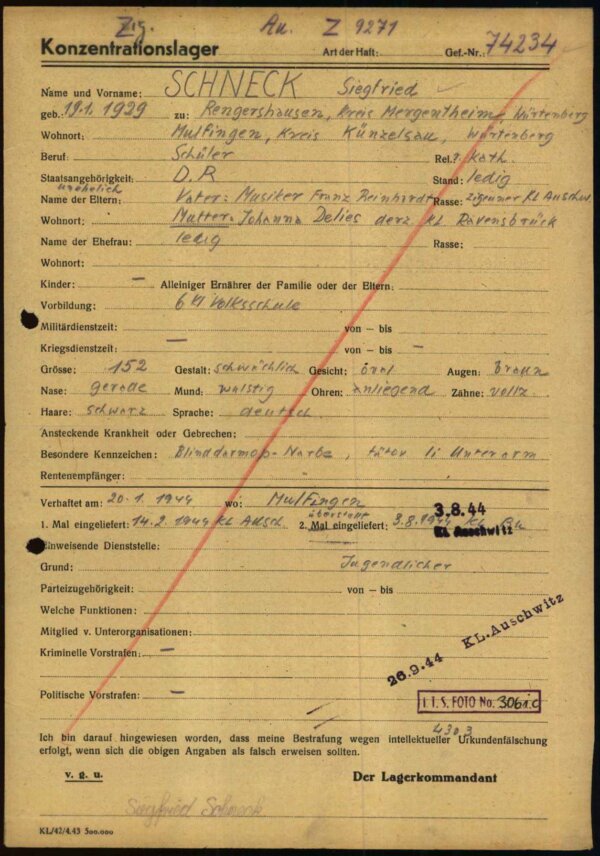A digital introduction to #everynamecounts!

Katharina Menschick has much to tell us about a new educational resource that has just been rolled out for #everynamecounts. She joined the Research and Education department in August 2020 as a research associate, and her primary responsibility is developing digital projects. She has recently been working with Henning Borggräfe, Christian Höschler, and Sabine Moller to create a digital introduction to the crowdsourcing initiative #everynamecounts. In this interview, she fills us in on the background to this online application and talks about the responsibility that lies with the Arolsen Archives to contextualize the archival documents in their care.
The international phase of the #everynamecounts campaign has just begun. The digital introduction was specially developed for this re-launch. Where did the idea come from?
The idea was born out of two considerations. Firstly, we felt it was important to explain the context in which the documents were created. The documents that are now being indexed for #everynamecounts were created in connection with the persecution and murder of millions of people, and they reflect Nazi ideology. At the same time, they’re often the last or even the only known testimony that we have to someone’s fate. The Arolsen Archives are charged with the task of preserving these documents and dealing with them appropriately – that’s a huge responsibility. And with the online publication of a large portion of our archival holdings comes a very special responsibility to explain both the context of their creation and their content.
Secondly, we know that many of the people who take part in #everynamecounts are working on their own from home, and the coronavirus pandemic has exacerbated this situation. It’s important to provide an introductory guide to this memorial project to do justice to the content of the documents and help people understand what they mean. And because the memorial project is only available online, the introductory guide has to be available online too, of course.
What is the digital introduction about?
The digital introduction is intended to help people get started with #everynamecounts. Ideally, volunteers will use the introduction before they start indexing documents. That way we can prepare them for what to expect. Each document bears witness to the fate of one or more persons, and the documents contain references to the extremely inhumane treatment these people received. We think it’s important to address this up front.
Not only does the introduction provide our volunteers with information about the documents themselves and about how they were created, it also describes how they came to be in Bad Arolsen and what the Arolsen Archives actually do with them. We explain why it is important to index the documents and make them searchable, and we touch on the significance they can have for relatives and researchers, for example.
How is the digital introduction structured?
The introduction focuses on a document that contains information on Sigfried Schneck, a Sinti boy who was deported and murdered at the age of 15.

Sigfried Schneck, a 15-year-old Sinti boy, was deported to Auschwitz and murdered by the Nazis. Our digital introduction uses this document to give a brief insight into the fate he and his family suffered and to provide information on the persecution of the Sinti and Roma.
We zoom in on different sections of the document one after the other, drawing attention to his name, his signature, and his place of residence, for example. Each of these sections of the document is explained in detail, and relevant background information is given. The introduction uses a three-step approach to help people to understand the information contained in the document: The first step is to “explore” the document, which involves learning how it was created and finding out how it ended up in Bad Arolsen. The second step is titled “reflect,” and involves a closer look at the circumstances surrounding the persecution of Siegfried Schneck and his family, and the persecution of the Sinti and Roma in general. The third step is to “participate.” This is the interactive part of the digital introduction to #everynamecounts. When you participate in #everynamecounts, it can sometimes be difficult to enter the data in the right way for it to be used effectively for the search function later on. So you get the opportunity to practice entering data here.
The final section is titled “Learn More.” It explores the different categories of imprisonment and persecution. It’s important to inform people who participate in #everynamecounts about these categories, so that the Nazi attributions recorded on the documents are not simply left uncommented.

Katharina Menschick’s work at the Arolsen Archives focuses on the question of how digital formats can be used to share knowledge about Nazi crimes and explain the documents in the Arolsen Archives. The digital introduction to #everynamecounts is the first project she’s worked on as a member of the Research and Education department.
Who is the introduction for?
While the digital introduction is intended for anyone who wants to participate in #everynamecounts, it was developed with a special focus on the needs of young people and students. It’s an opportunity to learn about persecution under National Socialism and to find out what the documents in the Arolsen Archives really mean. Working with the documents makes it clear to people that there is a human fate, a unique individual, a personal story behind every single name.
I have one last question for you: What makes the project particularly suitable for schools?
We want to support schools during the coronavirus pandemic, so we’ve created additional materials to meet their specific needs. There is advice for teachers on how to use the introduction in a lesson or for a project day and an annotated list of sources that explains all the images and documents that appear in the introduction in more detail. We hope the introduction will encourage students to take an on-going interest in the topic. We are also planning an #everynamecounts campaign for schools and are currently in the throes of developing more educational materials.
Thank you, Katharina, for giving us some inside information on the digital introduction to #everynamecounts!

